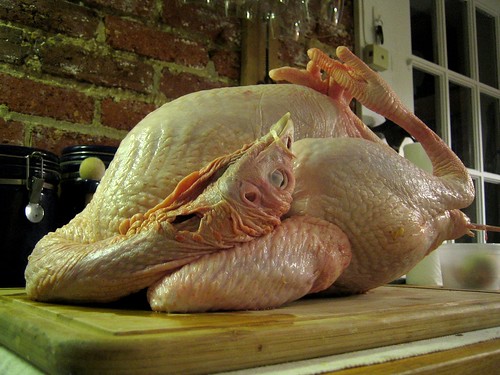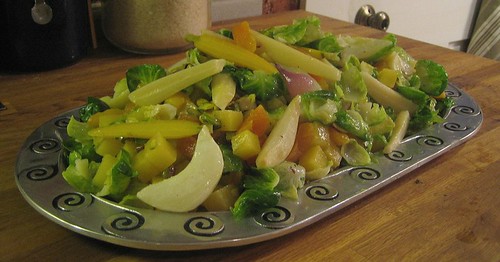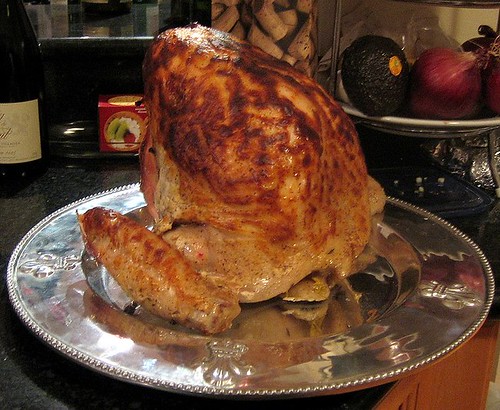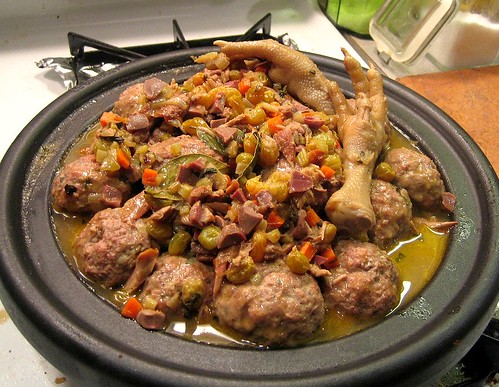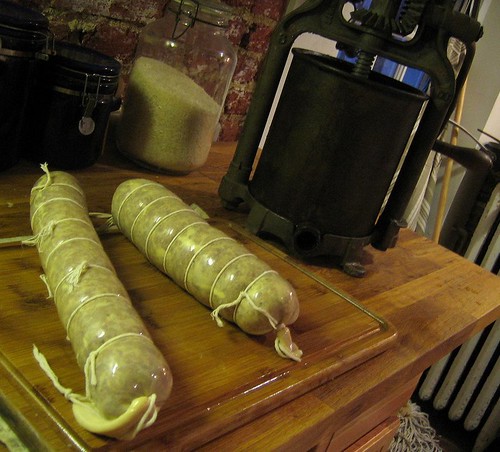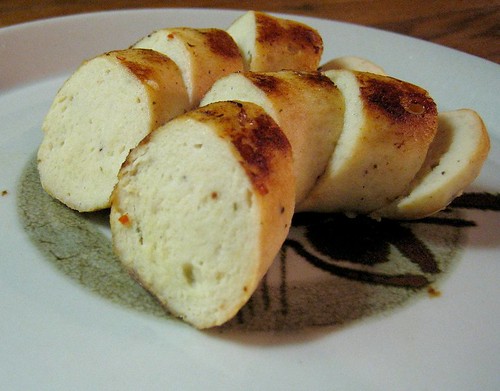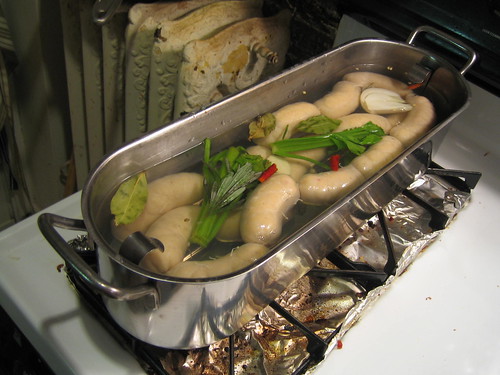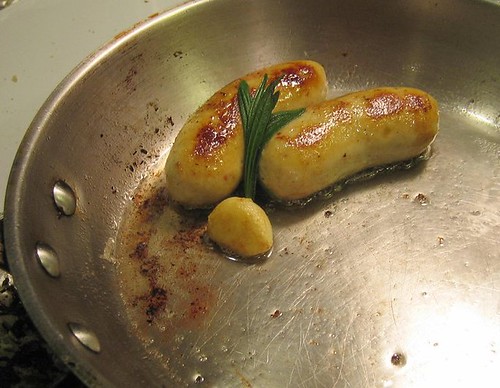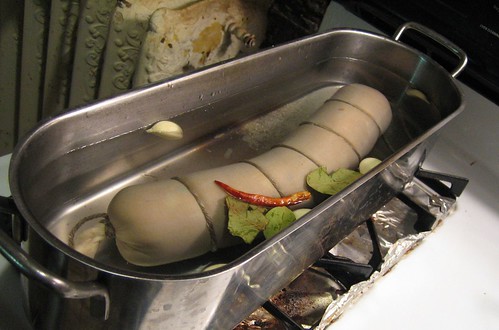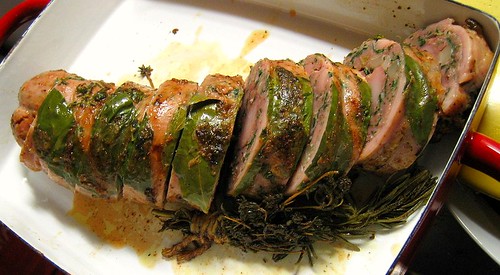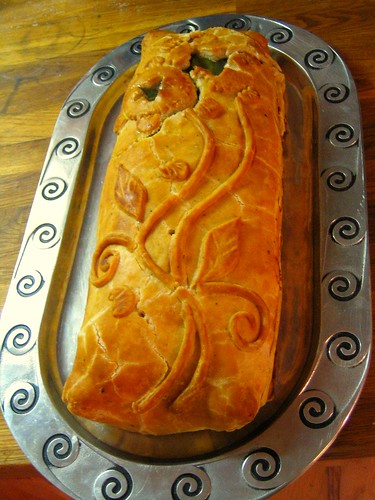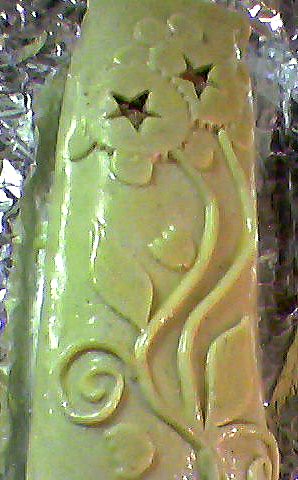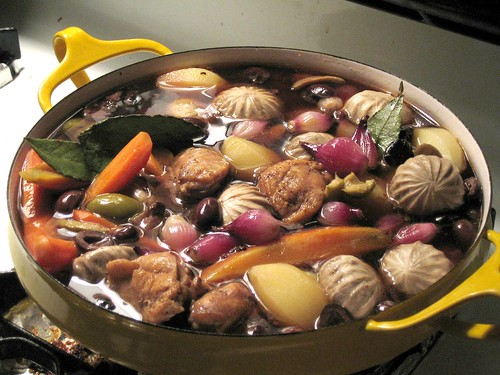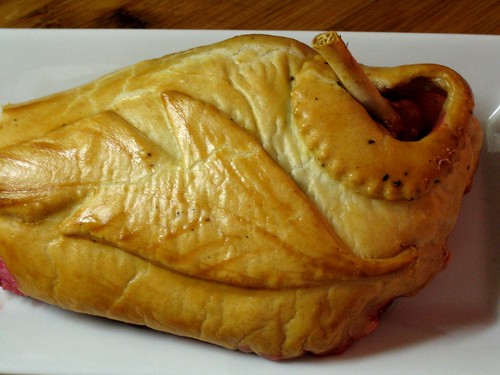Monday, September 28, 2009
Moving to Wordpress
http://kitschnclassics.wordpress.com/
The 2 of you who look at this every other hour or so will have another site to do the same.
Thursday, September 24, 2009
Let us talk turkey.
The epicurean’s stuperbowl is nary 2 months away and in order to get the cream of the guest crop, 2B3S (Gluttony Digest Editor and Prussian war re-enactor) and I are currently considering applications to offer 4 secular Thanksgiving day dinner seats to sophisticated guests with elegant sensitivities.
The hosts’ familiar guest base dwindles during the Thanksgiving season due to family obligations but previous feasts have been nothing short of deliciously successful save for a cornucopia of remarkably tactless infractions of etiquette by a few lowbrow guests who: 1. brought “Doritos” and other Frito-Lay products; 2. lost a tooth and was not bashful about showing it around; 3. asked for plates and served other convives like it was a prison cafeteria and started eating before the host had even seated; 4. tried to discuss fellatio with the prude red-head catholic girl; 5. yep, you guessed it, wore a fucking sweatshirt.
Refreshing pioneers and/or experts of any esoteric field, collectors, inventors, adventurers, marine biologists, history enthusiasts, roadie experience, comedic gift, convincing sleight of hand, Scandinavian women and foreign accents are preferred. Perspective guests should be able to provide sample anecdotes, 2 social references and agree to an interview at the bar of the Mayflower hotel (naturally). Gluttony, profuse perspiration, war crimes, boors, bores, louts, activists, political/religious zealots, kleptos, unfounded arrogance, podiatrists, prudes, picky palates, French Québécois accents and a standing height of over 6' 4" are deal breakers (due to low ceilings).
Selected guests are expected to wear clean shoes and dress appropriately: cardigan and corduroy for the gents; ankle length dresses and modest blouse for the hopefully busty ladies. Guests will bring a proper bottle of wine (which we can recommend) as a measure of gratitude and good form.
The entirety of the meal will be prepared in house by an accomplished cook host and adhere to the traditional format of hors d’oeuvres and libations, soup, hot appetizer, Amish Heritage turkey in 2 preparations, seasonal vegetables, stuffing, starch, desert, etc... Interested guest can send an e-mail query for more details and consideration
These previous menus should assuage any concerns of sustenance and cookery aesthetics.
TG2008: Hommage to Turkey
-11,000,000 milligram Amish Turkey (hence the cheeky currency denomination), Mulled Cider, Humus and Home, Made Pide Bread, Pickled Fish, Foie Gras, Red Lentil and Celeriac Soup, Potatoes with Anchovies and Cumin, Pumpkin and Barley Stuffing, Cranberry and Walnut Baklava, Backgammon, Massage
with Apricots and Pistachios
Monday, September 21, 2009
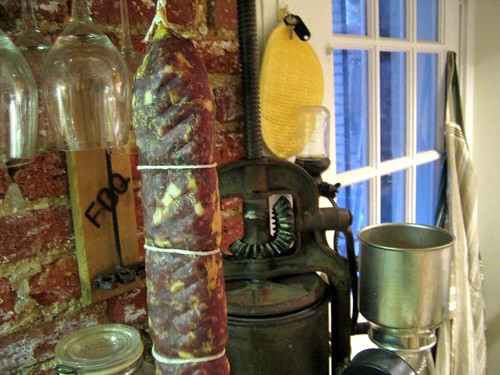
A liberal interpretation of “rosette” since a beef middle was use in lieu of the traditional and difficult to source pork rosette, the veritable terminus of the pig’s digestive tract whose shape and alleged “odor” give the rosette its reputed characteristic taper and… taste? After intense research through both professional and artisanal French charcuterie formulations, and a disastrous beta version, a widow of imperative seasoning proportions was tentatively established and put to test. The salt proportions varied from a well keeled 1.5% to a 3.5% Superbowl party saltlick.
Initially, based on the recurring 2.8%, such a quantity of salt was used but the result was unsavory, or rather extra savory and on the cusp of parching. And so the first foray into dry cured sausage (2 pieces) was unsuccessful but taught a fundamental lesson in fermentation after too lengthy of an incubation. The basement kitchen was thought to have been sufficiently cool and dark enough to support a longer incubation period but after a week in the upper 60’s, despite shrinking, both began to ferment. A better approach would have been to refrigerate one earlier and then compare notes.
Both sausages were refrigerated for 6 weeks in a home refrigerator at a cooler temperature than what would be ideal (44˚F so that other immediate perishables would not spoil) and began to develop a slight bloom after the 3rd week. The test of taste was a formidable challenge in gustatory fortitude after the first cut given that the cavities in the sausage were lined with spectacular green mold (insert blushing emoticon). The ends were salvageable and had a distinctively cured taste, though in the heavier spectrum of salty. Invariably, as with any endeavor, elements of theory and practice were learned at the expense of a failed product and applied to the next since anything worth ef’ing up once is worth ef’ing up twice and maybe thrice.
The 2.0 version was limited to 2.2% salt, the same .5% sugar (to help in the initial fermentation which creates lactic acid and bla-bla-bla) and 48 hours incubation, then into the fridge. After 4 weeks:
Current conclusion:
The 48hr incubation period, as recommended by Len Poli and other resources appears to have been effective and the sausage feels firm which would indicate that there are no cavities. Next update in another 4 weeks.
Thursday, September 17, 2009
White Boudin from Avranches
Boudin Blanc, Beta version. An emulsified chicken sausage with fatback, onions and a panade, poached and then browned in duck fat. Upon returning from a Labor Day weekend on what a generation ago was an entirely sustainable 275 acre farm in southwestern
Measurements were made based on the weight of the suspiciously yellow lab-raised protein do determine proportions of fatback, onion and bread/cream panade (French boudin designation can not exceed 5% starch content). The onions were sweated in foie gras fat with chili pepper, salt and lavender until soft, then cooked uncovered to evaporate any remaining water. The dried bread was soaked in cream and the chilled fatback was diced. All was ground though the small die and then puréed with the help of water and cream*, seasoned, paddled and pressed into hog casings. The boudins were poached in seasoned water (salt, chili, bay leaf, lavender, garlic) for 40 minutes, which in hindsight may have been twice too long. They were left to cool in the liquid.
To serve, the boudins were removed from their casings and browned in duck fat with garlic and lavender. While not entirely unpleasant, the chicken flavor was muted, perhaps due to the inferior product used or the traditional fillers.
Initial shortcomings and screw ups:
The cooked onions should have been moistened with a splash of sherry vinegar and some chicken glace to give a more pronounced poultry flavor.
*As for the texture, the forcemeat should have been ground twice through the fine die and then puréed without cream and more liquid (from the onions and panade) or whole milk to give a smoother final product as with the cervelas. The boudin’s texture was ever so slightly shamefully gritty, which may also have been a result of the cream breaking in the food processor. Eureka? In haste to find an authentic, vintage recipe, the properties to cream and modern technology were overlooked. Cream turns to butter in a food processor. The original recipe, which predated Pierre Verdun’s 1963 food processing gizmo –now generically dubbed the “Robot Coupe”, yet pronounced "Row-beau Coop"- called for pounding the forcemeat through a pedestrian sieve, just as generations dating back to Taillevent had done.
Wednesday, September 2, 2009
Cervelas de Mont Plaisant
aux pistaches et poivre noir
 Mount Pleasant Cervelas
Mount Pleasant Cervelaswith pistachios and black peppercorns
Behold the cervelas. An emulsified French pork sausage which varies regionally in terms of content and cookery. Certain Alsatian preparations call for the sausage be smoked or have it stuffed with gruyere and wrapped in bacon. Ouf.
In this comestible prototype the cervelas is a “white” emulsified pork sausage with pistachios, black peppercorns, fatback and spices stuffed into a beef middle. It is cooked in seasoned water for an internal temperature of 150˚.
Those in
The Swiss cervelas traditionally used, almost exclusively, Brazilian zebu casings, which were deemed the best, however recent European Unions regulations have banned the import of Brazilian beef since the World Organization for Animal Health listed
While the name is derived from the Roman renaissance term for sausage cervelatto from the diminutive Latin word for cerebrum (brain) since back in the day, cervelas allegedly used to contain brain, according to the CICT (Centre d'Information des Charcuteries-produits Traiteurs)
Hopefully this one, albeit humbler than the one served at Per Ser, will earn a better criticism. Personally, the final product's initial shortcomings were that the forcemeat could have benefited from slightly less water and perhaps cooked a bit longer and to a higher temperature of 160.
Monday, August 24, 2009
Dorades en portefeuille farci aux goûts d’été
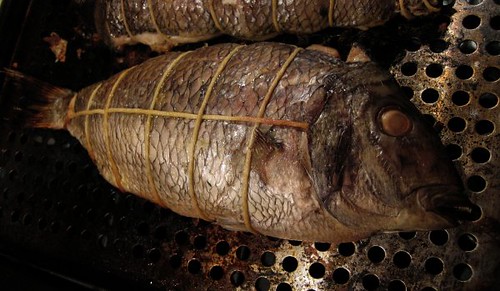 Porgies, purse style, stuffed with summer flavors.
Porgies, purse style, stuffed with summer flavors.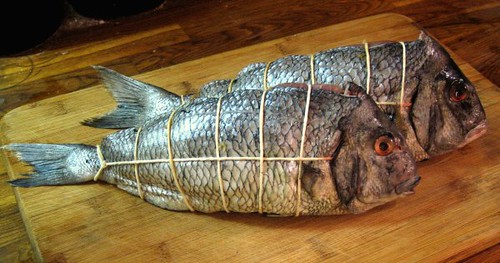
The stuffing: Essentially a bread salad with summer vegetables. The stuffing needed to be light and cooked so that it would suffice to be warmed through slowly without having to hammer the fish, giving you just enough time to flirt with and ultimately offend the lassies at the grill. The bread also helps to absorb any juices which would otherwise be lost. Stale sourdough was diced and toasted. Zucchini, yellow squash, and eggplant diced as well, all sautéed in olive oil not before letting the eggplant degorge some water after lightly salting. A red pepper was roasted over a flame, diced and added to the other vegetables. The entire mixture was bound with a soffrito of toasted garlic, dried chili, anchovies, diced red onion, tomato paste, lemon zest and segments. The stuffing was finished with chopped parsley, olive oil and a splash of sherry vinegar. The cavity of the fish was filled with the stuffing and tied shut with butcher’s string. A hot grill stood the chance of burning the string as well as cooking the meat before the stuffing had a chance to warm through so it was slowly cooked on a perforated metal sheet tray over a low grill.
Gustatory Conclusions: The fish was properly butchered and cooked. The stuffing however could have benefited from diced raw tomato for a higher water content. Some lemon slices under the string would have been a good source of acidity and a foil for the sticking skin.
Tuesday, August 18, 2009
et Graines de Moutarde
Second half of the Good Friday rabbit course. Boneless rabbit stuffed with a triptych purée/ground/dice forcemeat of rabbit (trimmings from the forelegs, liver, heart, kidney) pork, my lardo, swiss chard and mustard seeds with the loins inlaid lengthwise. The rabbit was deboned (bones used for the bombine base) in the same method as in for porchetta; the ribs and spine removed in one piece (like in Predator) from the underside as to give a rectangular meat canvas. Forcemeat is mixed, seasoned, wrapped in the meat and chilled to give it a firm shape.
Once chilled and firm, bay leaves and thyme are placed on caul fat and the roulade is wrapped whereupon it can be cooked and offered as either a cold galantine or hot ballotine.
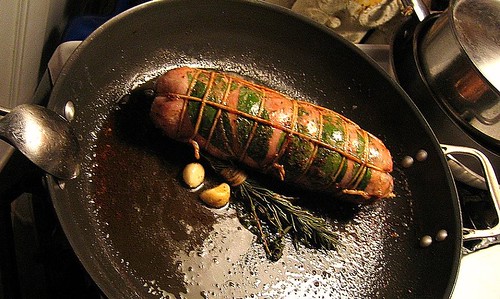
Galantine vs Ballotine?
Galantines and ballotines (ballantine is a brand of scotch whisky) are roulades but roulades are not necessarily galantines or ballotines.Roulade =any meat that is rolled around a stuffing made of vegetable, meat, dairy or whatever.
Ballotine = a galantine served hot.
Galantine = a meat, poultry or fish that is boned, stuffed with a forcemeat of the original protein and traditionally poached in a gelatinous stock and served with decorative aspic made from the stock and served cold or room temperature. Galantine comes from the Old French word for chicken “géline” or “galine” as it was originally made from chickens, though some maintain the word has its origins from the Gothic root “gal” meaning jelly, for the gelatinous stock. Towards the end of the 17th century it came to include other types of poultry, the remarkable Russian Doll Roast making use of 17 birds stuffed within one another being a remarkable example. The Bedouin camel stuffed with lamb, chickens and rice is on the furthest edge of the galantine spectrum, and its authenticity is debated. Zamponga stretches the roulade definition even farther and is the skin of a lamb or goat which is made into a bagpipes by bohemian Italians. Roger Waters used zampogna inspiration for the ubiquitous Pink Floyd pig-prop showmanship.
Wednesday, August 12, 2009
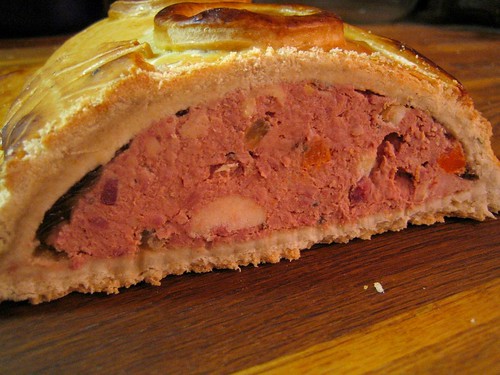
The dough was significantly better as well. Much sturdier though initially overwork in an effort to save it after erroneously using only half of the required water. The dough was rolled thicker and the seams were along the edge of the forcemeat rather than underneath as in the previous. The leaner forcemeat also helped maintain the integrity of the crust and it did not have to absorb/retain any cooking liquid.
Aesthetically the decorative feathers were successful though fluted chimneys would have been more classical. Cross hatches were made after 4 coats of egg-wash with the point of a knife. Not entirely necessary, more of a impulse and effort to keep the ends from being boringly bare.

Ultimately the pâté was well within the spectrum of success. The cooked forcemeat had good texture, taste and appearance as did the pastry. However, a few issues need to be resolved.
Shortcomings and accountability:
Forcemeat: The puréed portion of the forcemeat could have been smoother. It was ground once through the small die and then pulverized in the food processor. A smoother product could have been attained by either grinding the meat twice or more, or putting it in a blender (which I do not currently own) and then passing through a sieve. I was hesitant to pass the meat through a sieve as it is difficult to clean out the sinew and such afterwards.
Shortcrust: The amount of water called for in the recipe formulated from classical French resources looked excessive and roughly half was carelessly omitted since it looked too wet. As a result the dough was dry and brittle and broke apart when folded or stretched. In an effort to salvage the dough, more water was incorporated and naturally it became overworked and elastic making it difficult to work with.
Aspic: Not strong enough, melted at room temperature, again. It later came to my attention that gelatin sheets cancel out any natural gelatin in a consommé or stock and that a proper aspic should be made with 2% gelatin by weight.
Wednesday, August 5, 2009
édition speciale prunes et pistaches.
Recipe technique and theory (albeit not up to snuff but acceptable for an inaugural attempt) inspired by Larousse Gastronomique and Escoffier formulations for forcemeats and farce à gratin. Forcemeat was comprised of 20% farce à gratin, 60% ground meat and 20% cooked garnish (diced ham, beef tongue and fatback).
The prune and pistachio inlay (generally cooked chicken or duck liver -the Richelieu characteristic) was made by filling a star shaped tube with ground prunes and pistachios, freezing it, unmolding it and placing it in the middle of the forcemeat. The star shaped tube was fabricated by scoring an 11cm long piece of flexible plastic alternatively on the other side every 1 cm and then bending the plastic so t
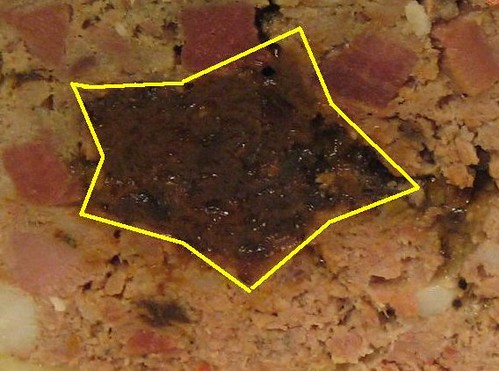 hat it folds like an accordion. The ends are brought together and overlapped producing a tube and when compressed a bit it makes a star.
hat it folds like an accordion. The ends are brought together and overlapped producing a tube and when compressed a bit it makes a star.Overall the pâté was a marginal success and failures are a vital bittersweet step in understanding what went right, what went wrong and why. A culinary mentor reminded me that anything worth fucking up is worth fucking up twice and urged me to consider how many things he had fucked up in a 35 year career. Successfully following a recipe does little more than prove solid reading skills and attention whereas understanding the theory comes from the practice and experience in experimenting the limits of fat, water, salt, temperature and time.
Initial, humble shortcomings:
1. Forcemeat: The meat was marinated in plum wine with olive oil, rosemary, carrot, onion, bay leaf, rosemary and a splash of cider vinegar. The vinegar should have been omitted as its purpose it better suited for marinated large joints or meats to be roasted and it may have cooked some of the meat and lead to oxidation. The cooked texture had a dry and crumbly appearance. It was not as tight and smooth as it should have been and had a brown-to-pink color gradient rather than pink throughout.
This may have been a result of the farce à gratin which was made by sautéing pork belly, the liver, red onion, deglazing and puréeing with 40% of the ground meat. If anything, the liver should have been cured with #1 to maintain a pleasant pink color, but ideally the farce à gratin should have been omitted or kept raw. When cooking, the forcemeat released a frightening amount of “juice”. The forcemeat may have been to fatty.
On the plus side, the flavor of the forcemeat was decent and the tongue garnish & ham was properly cooked (each inject with and cured in brine with curing salt for 4 days and simmer until tender in plainly salted water with a few vegetable aromatics until tender)
2. Pastry:
The short-crust pâte à foncer was 60% fat (½ butter, ½ lard) and after making the dough a few times the water amount should have been increased, though initially the dough looked too wet and I was hesitant to add the entire amount of water. The flavor was good and seasoned with salt (just a bit too much) and ground black pepper. The pastry was wrapped around the forcemeat and overlapped under the entirely. The overlap should have extended up the sides or the pasty should have been thicker. As the pâté cooked it compressed and its weight caused the pastry to tear and lose all the juices. The pastry should have held all the meat in place. Furthermore, a disastrous crack formed between the chimneys, ruining the visual aesthetics and handywork.
3. Aspic:
The aspic was far to thin (too little gelatin) and began to melt at room temperature. It was properly seasoned but could have used some Madeira or Port wine.
Conclusion:
The forcemeat should have contained all raw proteins outside of the garnish and been leaner. Vinegar should have been omitted from the marinade as it was likely to cause unsavory color change. The pâté itself should have been smaller and less forcemeat would have caused less structural issues. The pastry should have been thicker, especially in areas where liquid was likely to collect. The star should have been made from a cooked protein that wouldn’t have compressed. Apologies to Logan for using him, his celebration and guests as guinea pigs, though I ambitiously hadn’t anticipated a less than perfect specimen.
*The 0-4 star rating scale is stupid. If wines and school children are graded on a scale of 1-100, so should restaurants since the ½ star gradient does little to differentiate one restaurant from another or merit from more merit.
Wednesday, July 22, 2009
Friday, July 17, 2009
Carottes “WASA”
The carrots “WASA” garnish are carrots and leeks cooked in the traditional “Carottes Vichy” manner but with Washington DC Water And Sewer Authority water rather than that of the famed French hot mineral sping.
Wednesday, July 15, 2009
Tuesday, July 14, 2009
Jambonneau de Volaille
Jambonneau de Volaille en Chaud-Froid
Sunday, July 12, 2009
Top Chef Season 6

 and refreshing to watch now that dopey amateurs have been cut. Eve believes in the philosophy of French cooking (her Bravo bio is cut & pasted from her own website) and has Thai dumplings, Thai BBQ chicken, Cypriot cheese, curried mussels, nachos, risotto, coconut-ginger rice, beef chimichurri, macadamia encrusted salmon, tres leches and French bread on her menu. Bravo! She’s a sure bet in winning enough plastic wrap and not-so-biodegradable to-go tupperware to help open a Club Med franchise. If not, she can always fall back on the dream of owning her own restaurant which she has already fulfilled and the current cougar trend.
and refreshing to watch now that dopey amateurs have been cut. Eve believes in the philosophy of French cooking (her Bravo bio is cut & pasted from her own website) and has Thai dumplings, Thai BBQ chicken, Cypriot cheese, curried mussels, nachos, risotto, coconut-ginger rice, beef chimichurri, macadamia encrusted salmon, tres leches and French bread on her menu. Bravo! She’s a sure bet in winning enough plastic wrap and not-so-biodegradable to-go tupperware to help open a Club Med franchise. If not, she can always fall back on the dream of owning her own restaurant which she has already fulfilled and the current cougar trend.Hector brings the boorish brow of a serial rapist and an angry 245lb lobster’s disposition. Look for Hector to be driving the creepy ice-cream
 van in the "food truck challenge" while Bryan hawks seasonal freeze-smoked local tonka-bean
van in the "food truck challenge" while Bryan hawks seasonal freeze-smoked local tonka-bean  bearclaws with organic arugula foam and heirloom sprinkles out of the trunk of a State Trooper vehicle. (His penchant for caloric sweets was documented in Gluttony Digest Issue 3, Vol 1 page 8)
bearclaws with organic arugula foam and heirloom sprinkles out of the trunk of a State Trooper vehicle. (His penchant for caloric sweets was documented in Gluttony Digest Issue 3, Vol 1 page 8)Jolly flood victim and virgin hippie Kevin Gillespie may give the editors and lighting technicians more of a challenge than the other contestants based on the reflective nature of his pasty skin. It might crisp up nicely under powerful lights or could provide a Rubenesque canvas for a whimsical approach to the body-sushi-sandwich quickfire challenge.

Sideshow oddity Jesse Sandlin gives me the willies. The combinationof
 heft, metal thing through her lip and attention seeking tattoos make my testicles tingle (in a bad way), the sensation many males feel on the first descent on a roller coaster. So does “ranch “dipparoo”“ that accompanies the fried chicken at Abarcrombie Fine Foods which shares the distinction of being "world-famous" with hundreds of small town coffee shops, campy happy-hours and Virgin Island mahi-mahi burger shacks that I was unaware of until reading theself-professed planetary recognition in their windows.
heft, metal thing through her lip and attention seeking tattoos make my testicles tingle (in a bad way), the sensation many males feel on the first descent on a roller coaster. So does “ranch “dipparoo”“ that accompanies the fried chicken at Abarcrombie Fine Foods which shares the distinction of being "world-famous" with hundreds of small town coffee shops, campy happy-hours and Virgin Island mahi-mahi burger shacks that I was unaware of until reading theself-professed planetary recognition in their windows.
